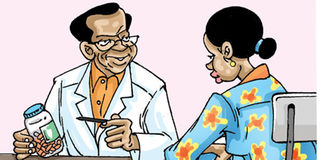Counselling: An important part in treating HIV/AIDSs

From the minute a person decides to take the HIV test, a counsellor’s role begins. Their job, however, does not stop at telling someone about the results of the test. Mary Shown writes the importance of counselling, before, during and after tests are done.
Helping patients accept their status
They are the ones who hold your hand before, during, and after your test. They are the ones who consult with you about your fears, your dreams and your expectations of your status. They are the ones who help you through HIV testing and treatment.
They are counsellors and are the first health professionals, persons speak to when getting tested for HIV. It is all part of a process that is meant to help people deal with the possibility of having HIV and taking ARVs for the rest of their life, as positively as possible. As they do this, counsellors must use gentle, friendly and detailed speech to form an essential relationship with clients to emphasise the importance of HIV information. They give their patients and friends the confidence to live positively and to become strong within themselves when the disease and medicine might make them feel weak. Counselling is therefore as essential to finding the cure for HIV as the production of new ARVs. Below, we look at the step by step process this entails.
Step 1
Pre-counselling
When a person goes to get tested, they first have a one-on-one talk with the counsellors about their expectations about the test, whether they think they are positive or negative, and what they plan on doing in both situations. Betty Nabukeera, a counsellor at the Aids Information Centre (AIC), asks hypothetical questions to help the clients understand the gravity of the situation. “If you are negative, how do you plan to stay negative? If you are positive, what do you plan to do?” After pre-counselling, they are tested by the clinicians. The test takes about 15 minutes to process as clients wait for the results that can change their lives.
Step 2
Breaking the news
Once the results come in, clients again speak with the counsellor about the results and what the next step is. When someone is diagnosed positive, Nabukeera emphasises how important it is to watch body language and to be as clear as possible about the results.
“We’ve detected HIV in your blood,” she says to clients. After that, the counsellor observes the client and their training gives them proper knowledge about how to tell with everyone’s different type of coping.
After being diagnosed with HIV, persons can be referred to and enrolled in clinics such as the Infectious Disease Institute, St Francis Home Care (Nsambya hospital), AIC, and many more. There, they are counselled and started on ARVs if they qualify.
“Some come for visiting and testing and then they get their results. If they are positive, then we enroll them in care if they are willing,” Francis Ssozi, a counsellor at St Francis Hospital Home Care said. “There are also those who come who are already tested and come from other laboratories or other clinics and hospitals and we then enroll them in care. There are also those who are referred from other ART providing centres and they come in as experienced patients.”
Step 3
Talking about the drugs
Before starting a patient on ARVs, each clinic has a specified routine that they follow in order to better help the client. Counsellors at the Infectious Disease Institute hold two counselling sessions.
“We discuss the general side effects of all ARVs during what I call the first Pre-HAART,” Eriphase Mugabi, a counsellor at IDI, says.
According to the World Health Organisation, HAART stands for highly active retroviral therapy, which consists of a three-drug combination that reduces replication of the HIV virus.
After discussing the general effects ARVs can have on the body, the counsellors and friends have a second Pre-HAART session to discuss specific side effects to the exact drug combination their doctor prescribed. “The clinicians also share these side effects with our friends since we work as a multidisciplinary team.” (‘Friend’ is a term IDI uses to refer to a client who is HIV positive). The term friend helps reduce stigma for clients and patients. Instead of one thinking they are speaking with another HIV positive person, they are instead speaking with a friend who has experienced similar situations. It can give a sense of belonging among the community.
Counsellors, doctors, nurses and other health care workers come together to better treat the patient as an individual and not just as another person infected. It shows the compassion and dedication these clinics and clinicians have when treating and helping those living positively.
Step 4
Visiting patients to ensure taking of drugs
Charles, an HIV-positive patient, is dependent on the conversations and treatment the clinics provide. He is a part of the Namugongo Fund for Special Children, which provides counsellors and doctors to visit his house on a daily basis to help with his medication and daily routine. “I knew [about HIV] in my heart and even the counsellors counselled me,” he said.
Going to homes like Charles’ and checking up on patients shows how essential counsellors are to the HIV treatment programme. It can save more than one person’s life. Mugabi, at IDI, sees up to 10 friends a day and primarily counsels discordant couples. Through his counselling methods, he has learned what to emphasise when talking to them as individuals.
“I listen to them as a couple, but speak with them as individuals,” he said. “The negative partners are the most at risk person so we must give them the facts.” He emphasises how no one is immune to HIV. “There are myths and we try to explain the issues of these myths and how they are not true.”




